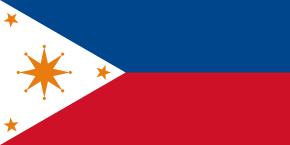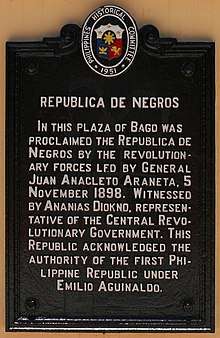Republic of Negros
The Republic of Negros (Hiligaynon: Republika sang Negros; Cebuano: Republika sa Negros; Spanish: República de Negros) was a short-lived cantonal revolutionary republic in the eponymous Visayan island, and later, an administrative division, which existed while the Philippines was under Spanish and American sovereignty.
Republic of Negros | |||||||||||||
|---|---|---|---|---|---|---|---|---|---|---|---|---|---|
| 1898–1899 | |||||||||||||
 | |||||||||||||
 Location of the Republic of Negros in the Philippines | |||||||||||||
| Status | Provisional Revolutionary Government (1898) Constituent of the Federal State of the Visayas (1898–1899) US Protectorate (1899–1901) | ||||||||||||
| Capital | Bacolod | ||||||||||||
| Common languages | Hiligaynon, Cebuano and Spanish | ||||||||||||
| Government | Republic | ||||||||||||
| President | |||||||||||||
• 1898-1899 | Aniceto Lacson | ||||||||||||
| Governor General of the Provinces | |||||||||||||
• 1899-1901 | Melecio Severino | ||||||||||||
| President of the Chamber of Deputies | |||||||||||||
• 1899-1899 | José Luzuriaga | ||||||||||||
| Legislature | Chamber of Deputies | ||||||||||||
| Historical era | Century XIX-XX | ||||||||||||
• End of the Negros Revolution | November 27, 1898 | ||||||||||||
• Surrender of Negros to U.S. forces | March 4, 1899 | ||||||||||||
| |||||||||||||
| Today part of | |||||||||||||
History

From November 3–6, 1898, the Negrenses rose in revolt against the Imperial Spanish authorities headed by the politico-military governor, colonel Isidro de Castro. The Spaniards decided to surrender upon seeing armed troops marching in a pincer movement towards Bacolod, the main city of the island. The revolutionaries, led by generals Juan Araneta, from Bago and Aniceto Lacson, from Talisay, were actually carrying fake arms consisting of rifles carved out of palm fronds and cannons of rolled bamboo mats painted black. On 5 November, Spanish officials surrendered themselves to native leaders. A provisional government was then established with Aniceto Lacson as President, and a notice of this was sent to Emilio Aguinaldo in Luzon.[3] On November 27, 1898, the unicameral Chamber of Deputies (Spanish: Cámara de Diputados) met in Bacolod and declared the establishment of the Cantonal Republic of Negros'(Spanish: República Cantonal de Negros). The Chamber of Deputies acted as a Constituent Assembly to draft a constitution. Eventually, the proposed constitution of the Federal Republic of Negros was not implemented.[4] On January 1, 1899, following the brief Negros Revolution in November 1898, the Federal Republic of Negros was proclaimed either as a sovereign state or a canton with two provinces. Notice of its establishment was sent to General Aguinaldo.
The Republic was surrendered to U.S. forces on March 4, 1899,[3][5] following the outbreak of hostilities between the nascent First Philippine Republic and the U.S. military government which had been established during the Spanish-American War, and came under U.S. protection on April 30, 1899 as a separate state from the rest of the Philippine Islands.[5][4] A constitution which proposed two governors, a U.S. military governor and a civil governor elected by the voters of Negros, was framed by a committee sitting in Bacolod and sent to General Otis in Manila and was proclaimed to take effect on October 2, 1899. The Republic operated smoothly under this constitution until the province of Occidental Negros was established on April 20, 1901,[6] and annexed to the Philippine Islands by the United States as The Republic of Negros.[7]
Republican leaders
The leaders of the short-lived republic were:[8]
Aniceto Lacson
(November 5, 1898 - November 27, 1898)
November 5, 1898 - July 22, 1899
(President in Negros Occidental only until November 27, 1898)
PresidentDemetrio Larena
(November 24, 1898 - November 27, 1898)
November 5, 1898 - July 22, 1899
(President in Negros Oriental only)
Vice-PresidentJosé Luzuriaga
July 22, 1899 - November 6, 1899President of the Chamber of Deputies Eusebio Luzurriaga Secretary of the Treasury Simeón Lizares Secretary of the Interior Nicolás Gólez Secretary of Public Works Agustín Amenábar Secretary of Agriculture and Commerce Juan Araneta Secretary of War Antonio Ledesma Jayme
July 24, 1854 - October 9, 1937Secretary of Justice Melecio Severino
November 6, 1899 - April 30, 1901Governor-General of the Provinces
Commemoration

In Bago, the event was chronicled in a historic marker found in the Public Plaza, which bears the following inscription:
REPUBLICA DE NEGROS
In this plaza of Bago was proclaimed the República de Negros by the revolutionary forces led by general Juan Anacleto Araneta, 5 November 1898. Witnessed by Ananías Diokno, representative of the Central Revolutionary Government. This Republic acknowledged the authority of the First Philippine Republic under Emilio Aguinaldo.
November 5 has been observed as a special non-working holiday in Negros Occidental through Republic Act No. 6709, signed by President Corazón Aquino on 10 February 1989.
References
- "The Two Republics of Negros". Retrieved 26 October 2012.
- "What is the República Negrénse?". Archived from the original on 30 September 2013. Retrieved 27 September 2013.
- Kalaw 1921, p. 148
- "Negros History". Sillman University. The Philippine Revolution.
- Two-article series:
- "Pacete: The fate of the Federal Republic of Negros". Sun-Star Philippines.
- "Pacete: The fate of the Federal Republic of Negros 2". Sun-Star Philippines.
- Victoriano D. Diamonon (1920). The Development of Self-government in The Philippine Islands. University of Iowa. pp. 22-25.
- Zaide, Gregorio F. (1970). Philippine Constitutional History and Constitutions of Modern Nations: With Full Texts of the Constitutions of the Philippines and Other Modern Nations. Modern Book Co. p. 34.
- WorldStatesmen. "Philippines - Republic of Negros". Retrieved 10 August 2010.
- Kalaw, Maximo Manguiat (1921). The Present Government of the Philippines. Oriental commercial. ISBN 1-4067-4636-3.CS1 maint: ref=harv (link)(Note: 1. The book cover incorrectly lists author as "Maximo M Lalaw", 2. Originally published in 1921 by The McCullough Printing Co., Manila)

